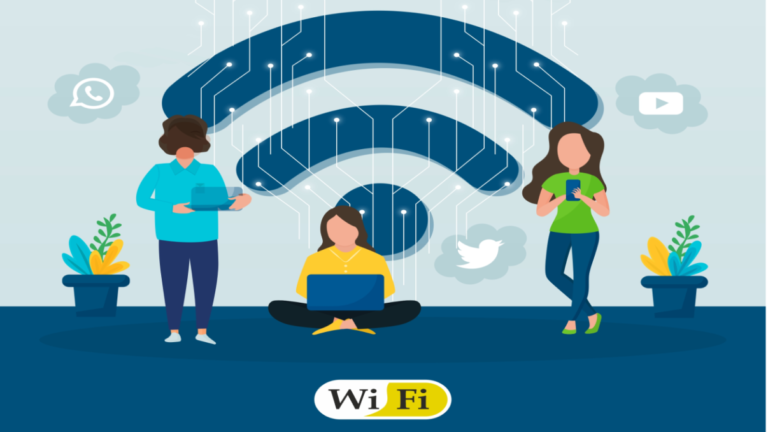Wifi is a wireless technology that is essentially utilised for connecting devices like computers, tablets, smartphones, wearables etc to the Internet. WiFi is not any standard acronym as it is often believed that Wireless Fidelity but it is not so but it is named that was given for its user-friendly nature.
About Wi Fi
Though the work on WiFi technology was started long back and the research work on it started in the context of defence research but for users, it has been available since the late 1990s and it uses radio waves to communicate between the devices and the efficiency of WiFi can be understood by a simple fact that the journey began with 2mbps speed of data transfer and today with the talks of WiFi 802.11be the speed is expected to be in the range of almost 40gbps.

In this blog, we will discuss this marvellous journey of WiFi evolution from 2mbps to potential 40gbps and then we will also discuss some of the most prominent advantages and disadvantages of WiFi technology and will end with a very brief overlook of the current status of WiFi and future outlooks.
History
Wifi was first released for consumer use in the year 1997 and in the background 802.11 committees were created. With the formation of this committee, there evolved a set of standards that are used to define the rules and procedures for wireless area networks. It is interesting to note that initially, the speed of data transfer between the devices was 2mbps.
2003 was an important and landmark year in the development of wifi as the 802.11g version evolved. This resulted in better speeds and wider coverage and also with the evolution of the 802.11g version, wifi started to catch up with their wired connections and from this point, the making of history began.
Another milestone to note is the year 2009 when a better and improved version of wifi came and it was named 802.11n. The better performance relied on multiple input multiple outputs (MIMOs) that employed the use of multiple antennas for both transmitter and receiver.
In the year 2012, a new version was introduced named 801.11ac that had the aim to make the 5Ghz frequency range more efficient.
The latest update in this series has been the introduction of WiFi 6 which came in 2020 and promises lower latency and higher speeds.
Success
Today WiFi is powering almost every aspect of our life and has become an integral part of our living and existence. It finds its application in telecommunications, health, education, defence, you name the sector and you will find the use of WiFi in that. Governments all around the globe are setting up public wifi networks to enable their citizens to make use of this revolution. Now let’s see a few advantages and disadvantages of WiFi that has come into the picture over almost two decades.
Advantages Of WiFi
Cost-Effective
This is one of the most important advantages of Wifi networks as it prevents the costs incurred on the wires and cables that were used in Local Area Network connections
User friendly
The setting up of WiFi networks is comparatively much simpler than the LAN connections and most of the WiFi connections and routers today come up with manuals for installations also there exists a sufficient number of videos available upon the Internet through which users can set up the WiFi networks by themselves and it eliminates the requirements of experts is setting it up.
Flexibility
The amount of flexibility that Wifi provides over the traditional LAN networks is beyond comparison. Users can be easily added and removed from the WiFi networks at will and do not require any separate procedure for that.
Coverage
The coverage that WiFi provides is admirable when compared with LAN networks. As the various versions of WiFi came into the picture right from the initial 802.11 to present WiFi 6 versions, each of them added to the coverage limits and extended it and at the same time reduced the latency experienced by users in the coverage limit. Modern Wifi networks have the capability to cover a range of more than 300 feet today.
Scalability
The number of devices that can be connected to the Internet through the use of WiFi is another feature that makes WiFi a really attractive option. Depending upon the strength and capability of Routers, the devices can be increased at will and if not required the number of devices can be scaled down at will too. So in effect, the aspects of Flexibility and Scalability are intertwined, and the twin benefits give an overall better user experience.
Options
Today several Internet service providers offer different packages to the users with varying numbers of devices that can be connected, the overall bandwidth, the pricing structure and with the availability of so many options in a free market, the user gets the control and choice to determine what option they want to depend upon their specific requirements.
Disadvantages of WiFi
Devices restriction
On one hand, it is also a benefit of WiFi networks that more devices can be connected to WiFi networks but with the broadband and other mobile and telecom services available today, the cap on the number of devices that can be connected to WiFi network acts as a major hindrance in the large scale expansion and adoption of WiFi networks for a larger public.
Security Threats
With the wireless connection as with any other wireless mode, the threats of viruses, malware, phishing attacks, hacking attacks pose a serious threat to the integrity and safety of connections and in recent years we have seen a surge in digital threats. The need of the hour is to balance this threat by more education and awareness campaigns for the online hygiene and precautions that users must adopt for an overall safer experience and to eliminate and minimise these threats.
Connectivity Issues
Although with the adoption of the latest versions of WiFi networks, this aspect has been controlled to a large extent but still the range and connection strength share an inverse relation and at wider distances, the signal strength sometimes lead to user irritation and helplessness.
Health Concerns
Though the results are not ye substantiated and more studies are going on there seems to be an emerging concern that WiFi networks that work on waves can lead to health concerns and has sometimes been related to oxidative stress that can cause damages to cellular macromolecules.
Current Status
IEEE 802.11 working group is the main body that is behind the creation of various standards for WiFi technology and as the users are getting used to the Wifi 6 standards, there have been various reports that the committee is working upon the latest version of Wifi and might be potentially called WiFi 802.11be that can lead to drastically reducing the latency rates and increasing both coverage limits and speeds and in some reports it is also mentioned that the speed can get as high as 40 Gbps.
Conclusion
The change and in a way revolution that WiFi has brought in since the late 1990s is extraordinary and it is sincerely hoped by users all over the Globe that whatever lacuna and disadvantages that presently exist which the usage of WiFi is solved and it could be utilised for various public utility purposes. In many developing and underdeveloped societies, it has opened the doors for telemedicine, online education and many similar fields which has the potential to change the lives of citizens for good. We will try to keep a close track of the evolution and development of WiFi technology and for more updates stay tuned with us.





